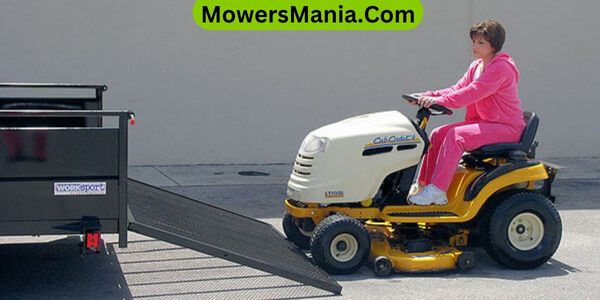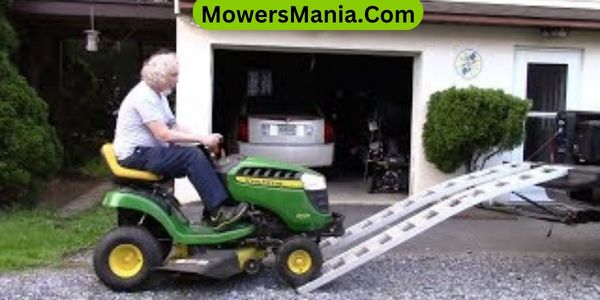Are you planning to transport your riding lawn mower but not sure how to do it safely and efficiently? Don’t worry, we’ve got you covered!
In this article, we’ll guide you through the process of transporting a riding lawn mower, from choosing the right trailer or truck to securely loading and unloading the mower.

With our tips and tricks, you’ll be able to transport your mower hassle-free and ensure it arrives at its destination in perfect condition.
Choosing the Right Trailer or Truck
To transport your riding lawn mower, you’ll need to choose the right trailer or truck for the job. This is an important decision as it will ensure the safe and efficient transportation of your mower.
When selecting a trailer, make sure it’s specifically designed to carry heavy equipment like riding lawn mowers.
Look for trailers with ramps for easy loading and unloading. It’s also crucial to check the weight capacity of the trailer to ensure it can handle the weight of your mower.
If you prefer using a truck, ensure that it has a bed or a flat surface large enough to accommodate your mower. Additionally, make sure the truck has a sturdy tie-down system to secure the mower during transport.
Remember to check your vehicle’s towing capacity before hooking up a trailer or loading your mower onto a truck.
Securing the Riding Lawn Mower on the Trailer
To secure your riding lawn mower on the trailer, start by positioning the mower in the center of the trailer bed. This will help distribute the weight evenly and ensure stability during transportation.
Once the mower is in place, follow these steps to securely fasten it:
- Use ratchet straps: Attach ratchet straps to the front and rear of the mower, making sure they’re tightly secured to the trailer. These straps will prevent the mower from shifting or sliding during transit.
- Secure the wheels: Use additional straps or wheel chocks to secure the wheels of the mower. This will prevent any movement and keep the mower in place throughout the journey.
- Check for stability: Before hitting the road, give the mower a gentle shake to ensure it’s securely fastened. If there’s any movement, readjust the straps and recheck for stability.
Remember, the key to safely transporting your riding lawn mower is ensuring it’s tightly secured on the trailer. By following these steps, you can have peace of mind knowing that your mower will arrive at its destination unharmed.
Safely Loading and Unloading the Mower

How can you safely load and unload the riding lawn mower?
Loading and unloading the mower requires careful attention to ensure both your safety and the mower’s protection. Start by positioning the trailer or truck bed in a level and stable location. Make sure the loading ramp is secure and has good traction.
Before loading, remove any attachments or accessories from the mower to reduce its weight. Next, engage the parking brake and turn off the engine.
Slowly drive the mower up the ramp, keeping a steady speed and maintaining control. Once on the trailer, secure the mower using straps or chains, ensuring it’s tightly held in place.
When unloading, take your time and make sure the area is clear of any obstacles. Slowly back the mower down the ramp, maintaining control and speed. Once unloaded, reattach any accessories and double-check for any loose parts.
Following these steps will help you safely load and unload your riding lawn mower, minimizing the risk of damage or accidents.
Preparing the Mower for Transport
Before loading and securing the riding lawn mower for transport, it’s important to properly prepare the mower.
Here are three essential steps to ensure a safe and hassle-free transport:
- Clean the mower: Begin by removing any debris, grass clippings, or dirt from the mower. Use a brush or compressed air to clean hard-to-reach areas. Cleaning the mower not only keeps it looking good, but it also prevents any loose debris from flying off during transport.
- Drain the fuel: It’s crucial to drain the fuel tank before transporting the mower. Gasoline can be flammable and hazardous, so it’s best to empty the tank completely. Run the engine until it stops to use up any remaining fuel, and then carefully drain the tank into an approved container.
- Secure loose parts: Check for any loose or removable parts on the mower, such as attachments, baggers, or blades. Remove these parts and secure them separately to prevent damage during transport. Use zip ties or bungee cords to secure loose cables, belts, or hoses that could potentially get tangled or damaged.
Additional Tips for a Smooth Transport Experience

For a smoother transport experience, make sure to securely fasten the riding lawn mower using multiple straps. This is essential to prevent any shifting or movement during transport, which could potentially cause damage to the mower or pose a safety risk.
Start by placing one strap around the front of the mower, securing it tightly to the trailer or truck bed. Then, attach another strap around the back of the mower, making sure it’s also securely fastened.
Additionally, it’s recommended to use a third strap to secure the middle or center portion of the mower, providing extra stability.
In addition to using multiple straps, there are a few more tips to ensure a smooth transport experience.
First, be sure to remove any detachable parts or accessories from the mower, such as the grass catcher or bagger, to prevent them from getting damaged or lost during transport.
It’s also a good idea to lower the cutting deck to its lowest setting to minimize the overall height of the mower. This will help avoid any clearance issues or potential damage when passing under low bridges or overhangs.
Frequently Asked Questions [FAQs]
How Often Should I Transport My Riding Lawn Mower?
You should transport your riding lawn mower as often as necessary. It depends on factors like the need for maintenance, relocation, or storage. Regularly check for any damage or wear before transporting.
Can I Transport My Riding Lawn Mower in a Regular Car?
Yes, you can transport your riding lawn mower in a regular car. However, it’s important to ensure that the mower is securely fastened and that the car has enough space to accommodate its size.
Can I Transport My Riding Lawn Mower Without a Trailer or Truck?
You can transport your riding lawn mower without a trailer or truck, but it may not be ideal. Consider using a pickup truck or renting a trailer for safer and more efficient transportation.
Is It Necessary to Drain the Fuel From My Riding Lawn Mower Before Transporting It?
Yes, it is necessary to drain the fuel from your riding lawn mower before transporting it. This will prevent any leaks or spills during transportation and ensure a safer journey.
Are There Any Special Precautions I Should Take When Transporting My Riding Lawn Mower in Extreme Weather Conditions?
In extreme weather conditions, you should take special precautions when transporting your riding lawn mower. Make sure it is securely covered and protected from rain, snow, or high winds to prevent any potential damage.
Conclusion
Make sure to choose the right trailer or truck for transporting your riding lawn mower.
Secure the mower properly on the trailer to prevent any movement during transport. Safely load and unload the mower to avoid any accidents or damage.
Lastly, prepare the mower for transport by removing any attachments and securing loose parts.
Following these tips will ensure a smooth and successful transport experience for your riding lawn mower.



